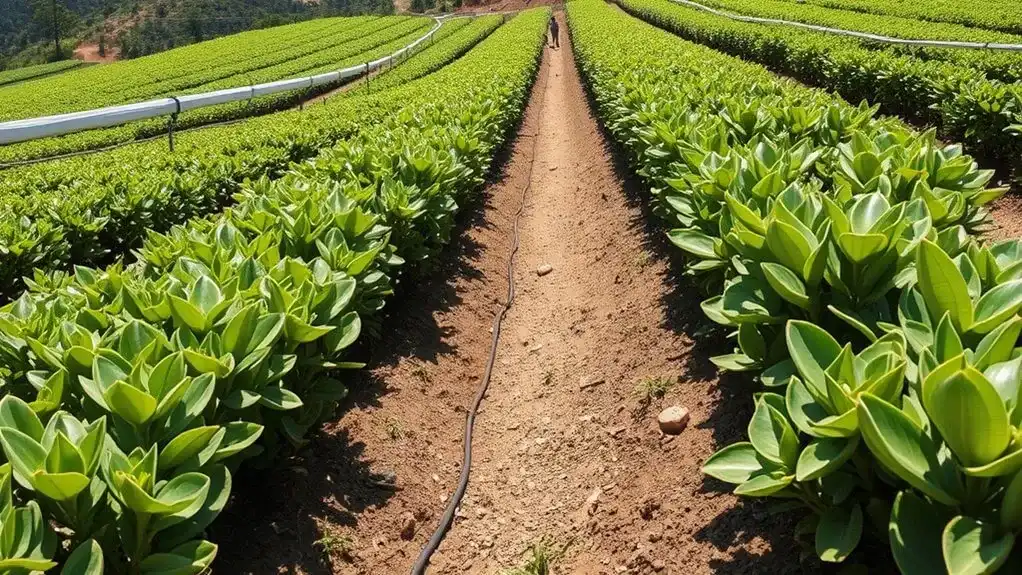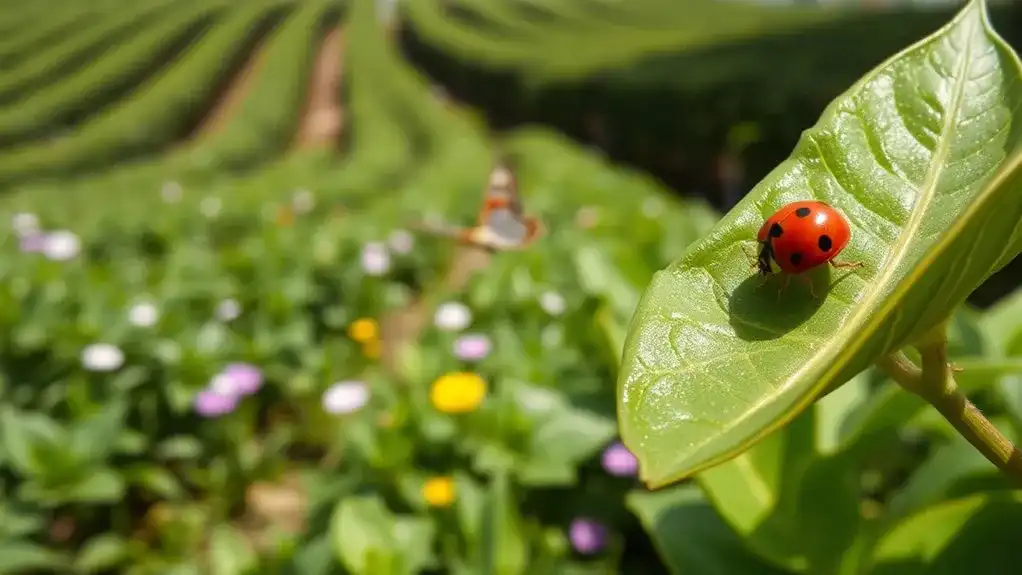Tea gardens worldwide are adapting to climate change through innovative drought-resistant methods. They're implementing advanced drip irrigation systems with IoT sensors that cut water usage by 50% while maintaining quality. Climate-smart varieties like TSS 2 show remarkable resilience against high temperatures, and agroforestry practices create protective microclimates for tea plants. Modern technology, including AI-powered monitoring and drone assessment, works alongside traditional wisdom to guarantee sustainable production. These emerging solutions offer promising pathways for the tea industry's future.
Key Points
- Climate-smart tea varieties like TSS 2 are engineered to withstand high temperatures while maintaining quality and yield despite water scarcity.
- Advanced drip irrigation systems with IoT sensors reduce water consumption by 50% while ensuring optimal growing conditions.
- Agroforestry integration creates protective microclimates and enables tea plants to access deeper water through tree root systems.
- Smart technology combines AI weather analysis and drone monitoring to optimize irrigation schedules and improve farming efficiency.
- Rainwater harvesting methods and natural conservation techniques like mulching preserve soil moisture and enhance water management.
The Growing Challenge of Water Scarcity in Tea Gardens
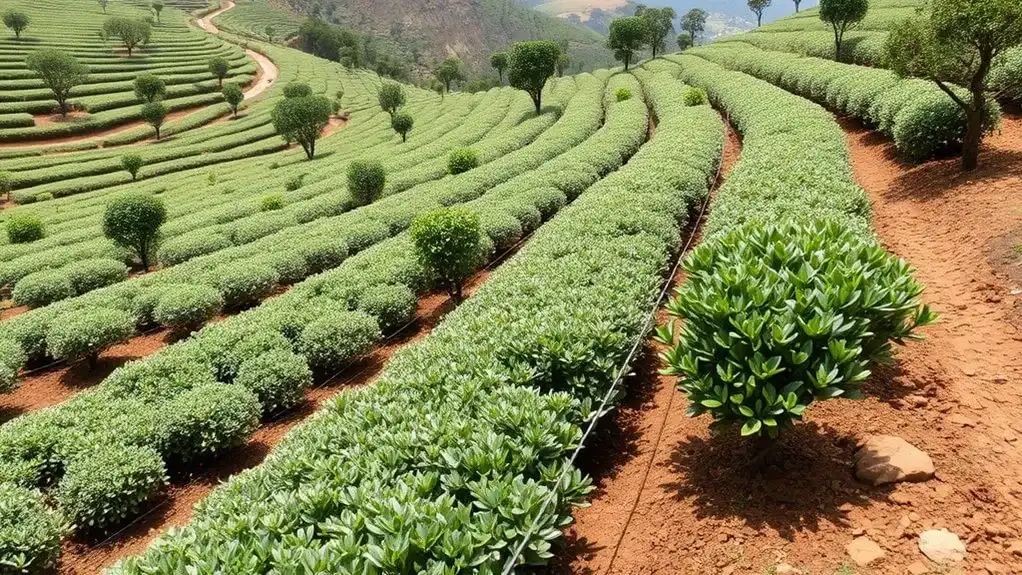
As climate change intensifies, tea gardens worldwide face unprecedented challenges with water scarcity. Changing rainfall patterns have led to severe droughts, compromising both tea yield and quality as leaves struggle to maintain adequate water content. Tea gardens now grapple with a complex web of issues stemming from water scarcity, including soil erosion, degradation, and the emergence of new pests and diseases. Some gardens have found success implementing drip irrigation systems and other water-saving techniques to maximize efficiency while reducing overall consumption. Tea growers in regions like Yunnan and Assam have observed significant changes in their tea's flavor characteristics due to these environmental stresses. The impact extends beyond the plants themselves, hitting indigenous communities and tea estate workers particularly hard. These workers must now dedicate more time and effort to water collection, disrupting their daily routines and productivity. The situation is further complicated by competing water uses that strain the already limited resources available to tea gardens. Global climate models paint a concerning picture, projecting rising temperatures and shifting precipitation patterns that will likely worsen water scarcity in tea gardens, threatening the industry's long-term sustainability.
Climate-Smart Tea Varieties: A New Hope
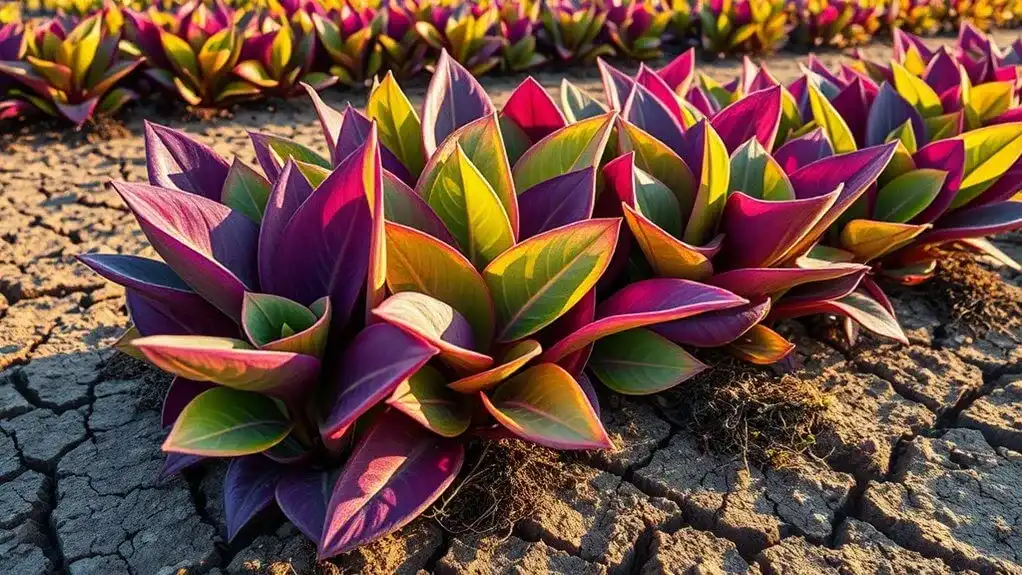
In response to mounting water scarcity challenges, agricultural scientists have developed promising climate-smart tea varieties that offer new hope for the industry's future. The Tea Research Association's new variety, 'TSS 2', stands at the forefront of climate adaptation strategies, specifically designed to withstand high temperatures while maintaining tea quality preservation. The introduction of microbial formulations in collaboration with Varsha Biotech aims to reduce chemical pesticide usage while promoting healthier crops. Recent cultivation patterns show a significant northward shift of tea plantations as farmers adapt to changing climate conditions.
This breakthrough couldn't come at a more critical time, as tea production has dropped by 80 million kgs in 2024 due to extreme weather conditions. Traditional growing patterns in Assam and north Bengal have been severely disrupted, but TSS 2 shows remarkable resilience. The variety's ability to thrive in harsh conditions while producing high-quality crops represents a significant advancement in sustainable tea cultivation. The Central Insecticides Board has officially approved these new agricultural practices. Ongoing research continues to explore the plant's responses to various climate-induced stressors, paving the way for future innovations.
Modern Technology Meets Traditional Wisdom
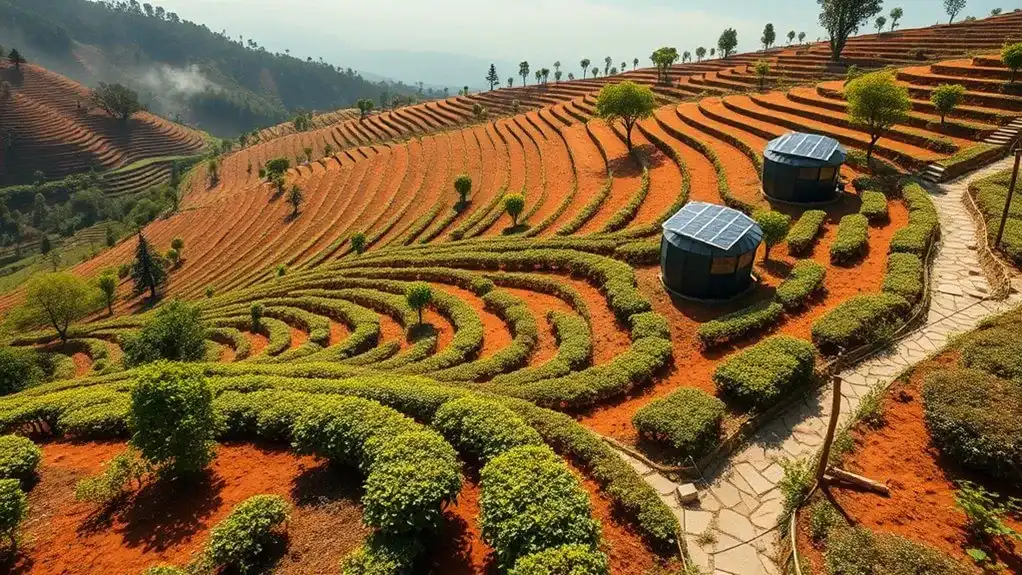
While traditional tea cultivation methods have endured for centuries, modern technology has revolutionized drought-resistant farming practices. Today's farmers combine traditional practices like agroforestry and mulching with AI-powered solutions to create resilient tea gardens. Smart sensors monitor soil health and moisture levels, while drones assess crop conditions from above. Precise weather forecasts help farmers prepare for changing climate patterns in advance.
The integration of technology with time-tested methods has proven particularly effective in water management. AI systems analyze weather patterns and soil moisture data to enhance irrigation schedules, while traditional soil conservation techniques help maintain ideal growing conditions. This hybrid approach isn't just for large plantations – small-scale farmers now access AI tools through platforms like Virtual Agronomist, which provides expert guidance via WhatsApp. Machine learning algorithms are now being used to predict optimal fermentation times and resulting flavor profiles. Employing these innovative methods has become crucial as tea yields in Kenya can drop by up to 30% during severe droughts. The result is a sustainable system that respects traditional wisdom while embracing modern innovation.
Sustainable Water Management Systems
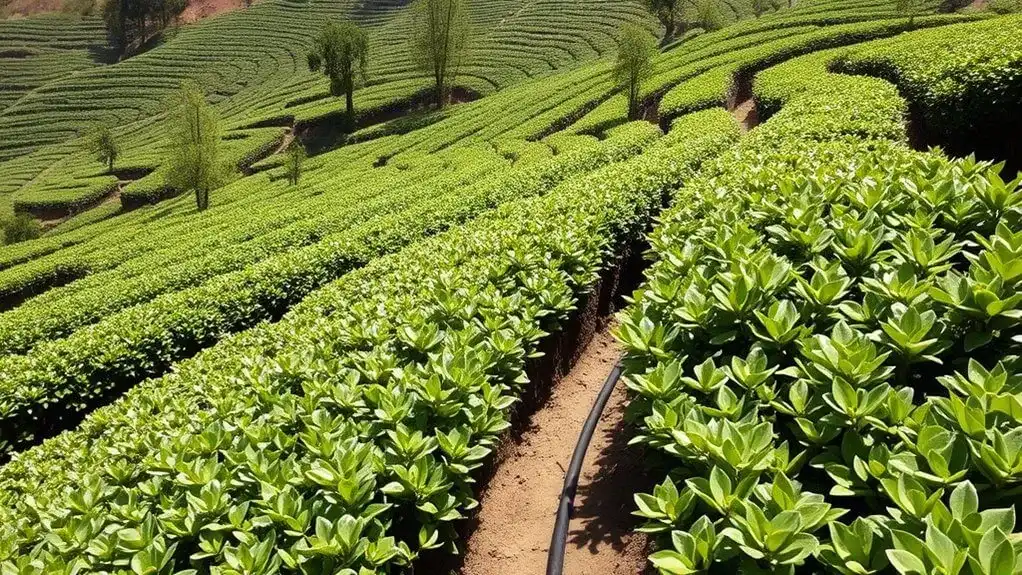
The integration of sustainable water management systems builds upon the fusion of traditional and modern approaches. Tea gardens are implementing advanced drip irrigation technologies equipped with IoT sensors that monitor soil moisture levels and enhance water delivery directly to plant roots. These systems can reduce water consumption by up to 50% while maintaining ideal growing conditions. Clean water access remains vital for sustainable tea production and ecosystem health. Water recycling initiatives now include sophisticated rainwater harvesting methods that collect and store precipitation for multiple uses throughout the garden. These systems not only reduce dependence on groundwater but also help maintain soil fertility. Gardens are complementing these technologies with natural conservation techniques like mulching and cover cropping, which preserve soil moisture and enhance biodiversity. The implementation of these practices helps address growing soil degradation challenges in tea-producing regions. The transition from synthetic fertilizers to organic alternatives has become a crucial adaptation strategy for many tea estates. Together with solar-powered irrigation pumps, these sustainable practices are creating resilient tea gardens that can thrive despite increasingly unpredictable climate conditions.
Role of Agroforestry in Drought Resilience
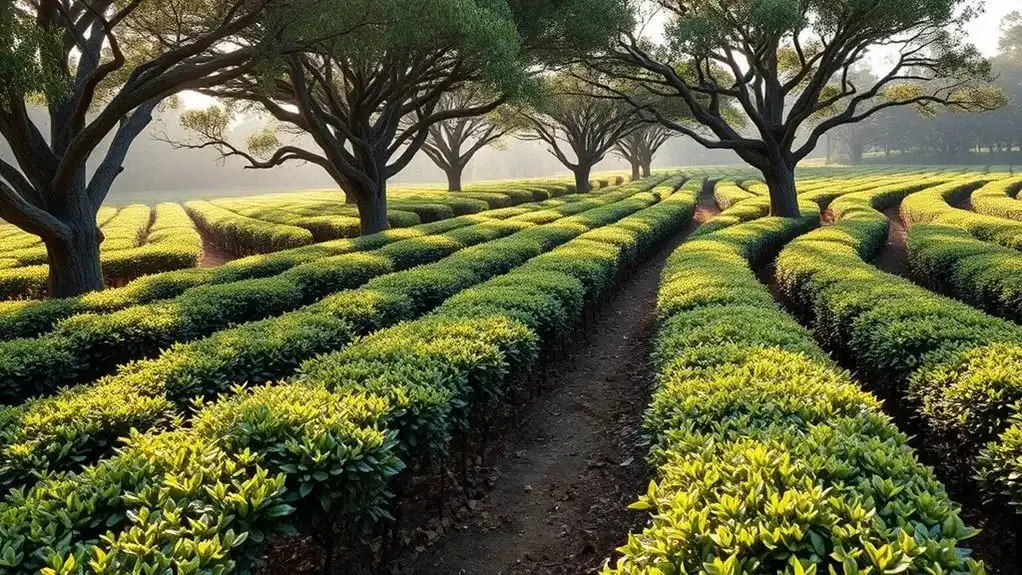
Agroforestry practices have emerged as a cornerstone of drought-resistant tea cultivation, offering multiple layers of protection against water scarcity. Tree integration creates beneficial microclimates that shield tea plants from extreme temperatures while their roots stabilize soil and enhance water retention. Fast-growing species like Gravillea and Albizia provide essential shade without competing for nutrients. The advanced deep root systems help tea plants access water and nutrients during prolonged dry spells.
Among the key agroforestry benefits is biodiversity enhancement, which naturally deters pests and reduces reliance on chemical pesticides. The forest-like environment promotes soil health through nitrogen fixation and improved water quality. Tea farms using agroforestry methods have shown a 68% reduction in chemical fertilizer use through waste-based solutions. While adoption challenges exist, including farmer skepticism and the need for training, successful implementation can generate additional income through timber and fruit trees. Consumer awareness trends are driving increased demand for sustainably produced tea from agroforestry systems. These sustainable practices demonstrate how tea gardens can adapt to drought conditions while maintaining productivity and environmental balance.
Hyperspectral Imaging: Revolutionizing Tea Plant Assessment
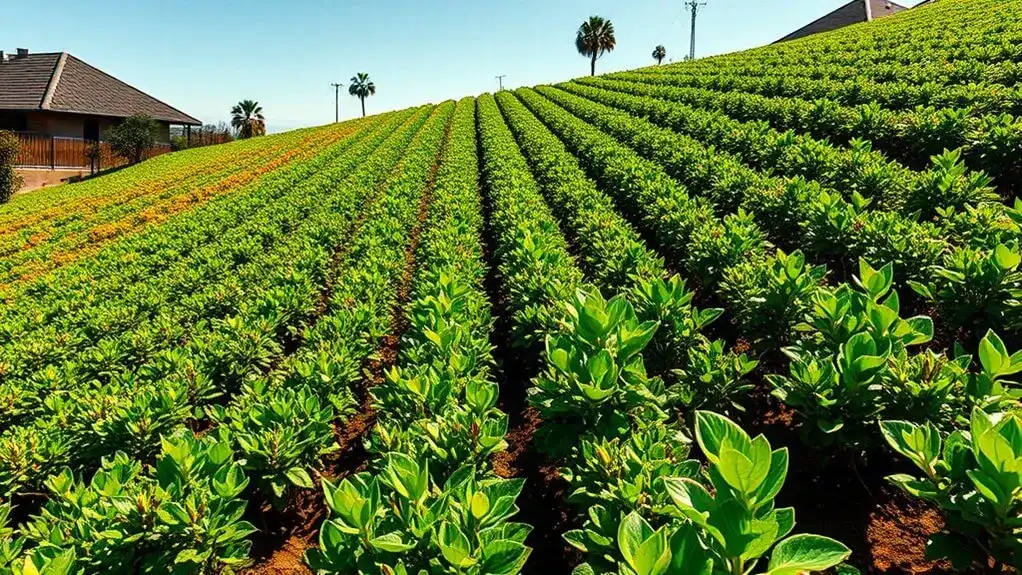
Modern agricultural monitoring has taken a quantum leap forward with hyperspectral imaging (HSI) technology in tea plant assessment. This non-destructive technology combines spectroscopy and computer vision to evaluate tea plants' responses to drought stress in real-time. Through phenotypic analysis, HSI captures essential data about plant health, stress responses, and growth status across the visible to near-infrared spectrum. Given that optimal tea growth requires temperatures between 13-26°C, HSI technology has become crucial for monitoring temperature-related stress.
Key hyperspectral applications in drought-resistant tea cultivation include:
- Real-time monitoring of plant tissue composition and water content
- Early detection of stress responses before visible symptoms appear
- Large-scale evaluation of drought resistance traits across tea gardens
Machine learning models are enhancing HSI's effectiveness by processing complex spectral data, making it an invaluable tool for modern tea cultivation and breeding programs focused on drought resistance.
Success Stories From Global Tea Gardens
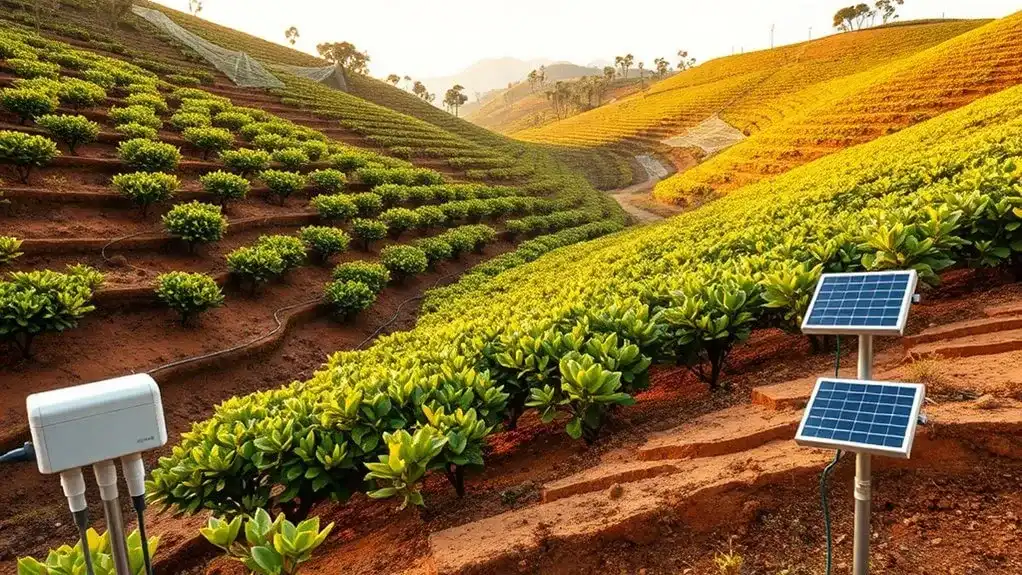
Across diverse regions worldwide, tea gardens are demonstrating remarkable success in adapting to climate challenges through innovative solutions and sustainable practices. These success stories highlight how gardens are implementing drought-resistant varieties and advanced water management systems to guarantee sustainable production.
Global innovations include the integration of regenerative agriculture, where farmers are diversifying their crops with avocados and bananas to create natural shade and enhance biodiversity. Community cooperatives have played a significant role in spreading these sustainable practices, particularly among smallholder farmers. The adoption of these methods has led to reduced agrochemical use while maintaining strong yields. In many regions, the combination of molecular breeding techniques with traditional farming methods has produced resilient tea varieties that thrive in changing climatic conditions. These adaptations, supported by policy initiatives and research collaboration, are transforming tea cultivation into a more climate-resilient industry.
Economic Impact of Drought-Resistant Cultivation

While drought-resistant tea cultivation requires initial investments, its economic benefits considerably outweigh the costs for farmers and producers. Adaptation strategies like using drought-resistant clones and improved drainage systems can boost yields by up to 68% and 50% respectively, offsetting the initial expenses of implementation. The most successful farmers have found that combining multiple resilience-building approaches creates long-term financial stability. The development of TSS 2 seed stock provides farmers with a temperature-resistant variety that ensures sustained production despite climate challenges. With research showing increased CO2 levels can enhance tea yield production, farmers are implementing controlled growing environments to maximize this benefit.
Key economic benefits of drought-resistant cultivation:
- Reduced crop losses during extreme weather events, protecting up to 80% of young tea trees
- Lower operational costs through sustainable practices and efficient water management
- Enhanced market competitiveness due to more consistent yield and quality, even during challenging climate conditions
These improvements help protect the livelihoods of tea farmers while ensuring the industry's sustainability against increasing climate pressures.
The Future of Climate-Resilient Tea Production
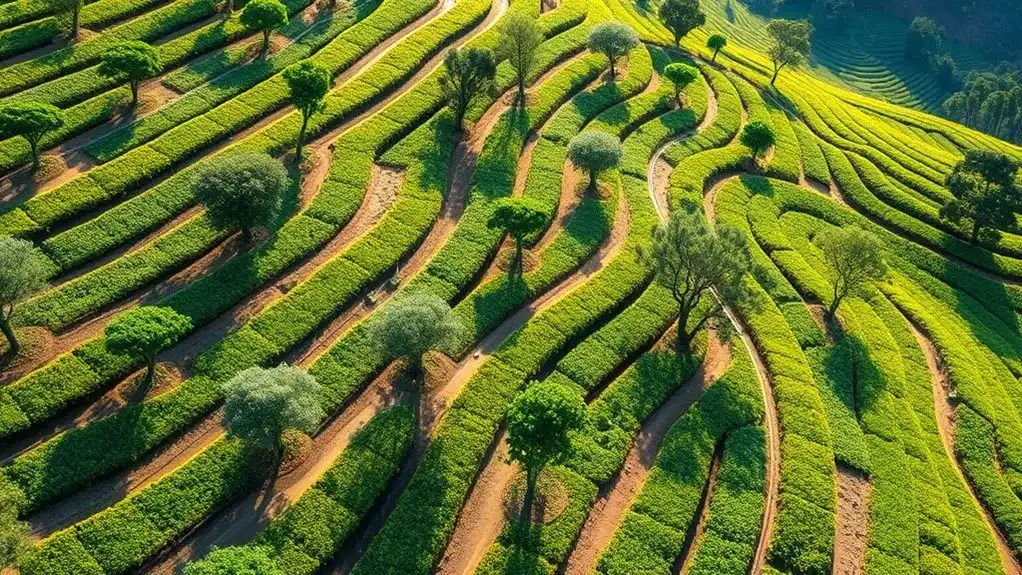
As climate change continues to reshape global agriculture, the future of tea production hinges on developing thorough resilience strategies. Researchers are exploring climate adaptation strategies that combine traditional knowledge with cutting-edge technology, including advanced crop modeling and omics tools to enhance genomic resilience in tea plants.
The path forward involves interdisciplinary collaboration, merging molecular research with ecological insights to create sustainable solutions. Scientists are using transcriptomics and proteomics to identify stress-resistant traits while implementing practical farming methods like terracing and water conservation. They're also developing new drought-tolerant varieties and integrating satellite imaging for precise crop management.
This multi-faceted approach promises a more resilient tea industry that can withstand temperature fluctuations, drought stress, and extreme weather events while maintaining crop quality and yield.
Conclusion
Tea gardens worldwide are evolving like resilient phoenixes rising from parched earth. Today's drought-resistant cultivation methods blend time-tested wisdom with cutting-edge technology, painting a promising future where lush tea leaves flourish despite climate challenges. As gardens embrace these adaptations, from precision irrigation to hardy varieties, they're not just surviving – they're thriving. The gentle rustle of healthy tea bushes whispers a story of human innovation meeting nature's challenges.
